Fig (1)
The total eclipse of the Sun
http://www.vt-2004.org/mt-2003/mt-2003-sun-corona-normal.jpg
A total eclipse of the Sun is one of the grandest natural phenomena and the most spectacular celestial event. A total eclipse of the Sun occurs when the Moon passes between the Sun and the Earth and obscures the Sun completely.
Total eclipses of the Sun are the result of an amazing coincidence. The Sun's diameter is about 1,394,000 km or 400 times larger than that of the Moon (3,476 km), but the average distance to the Sun is also about 400 times larger than that of the Moon. So, the two objects appear in the sky with nearly the same size.
Due to this coincidence, we enjoy the marvelous phenomena of the total solar eclipses, which we explore in this article. This coincidence is also unique in our Solar System; there are over 150 moons in the Solar System; but none looks similar in size to the Sun as seen in the sky of its parent planet!
For example, an observer situated on Jupiter would see total eclipses of the Sun by any of the four major Jovian moons, but these eclipses would be far less spectacular than our total solar eclipses. This is because these moons appear much larger than the Sun in the sky of Jupiter and the solar corona does not appear in its full grandeur during the Jovian solar eclipses.
Usually, there is a total solar eclipse visible somewhere on the Earth every 1.5 years. From a given location, e.g., Alexandria, there may be hundreds or even thousands of years between two successive total solar eclipses. A total solar eclipse is a lifetime experience.
Totality is very brief, lasting usually about 2 minutes, but in rare cases it lasts over 7 minutes. For a few seconds or minutes, the Sun disappears completely behind the dark disk of the New Moon; the sky becomes dark enough for the brightest stars and planets to appear. The sky is then as dark as twilight.
Only in the darkness of totality, the solar corona, the outer atmosphere of the Sun, can be viewed with the unaided eye. Thousands of amateur astronomers and enthusiastic eclipse chasers travel across the globe to glimpse and photograph the charming corona, but the human eye can perceive the delicate structure of the corona better than the camera.
Scientists and eclipse chasers paid $12,000 each to make an eclipse expedition to Antarctica, the white continent, to observe the total solar eclipse of 23 November 2003. This was the first recorded total solar eclipse in Antarctica.
A total eclipse of the Sun also features several fascinating solar phenomena such as the shadow bands, Baily's Beads, and the Diamond Ring.
You can enjoy a solar eclipse most if you know how to watch it safely and what phenomena to expect. In this section we explore the nature of total solar eclipses and what we expect to observe during the total solar eclipse of 29 March 2006.
In a total solar eclipse the Earth, Moon and Sun are so lined up that the Moon passes precisely between the Sun and the Earth, and the shadow of the Moon falls on Earth and moves over it.
Fig (2)
The geometry of a total solar eclipse
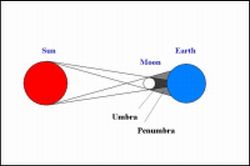
A solar eclipse occurs only when the Moon is at the new phase. The New Moon cannot be seen until it moves across the face of the Sun.
Like a tree, a building or yourself, the Moon has a shadow in sunlight. The shadow of the Moon is 374,000 km long (the Earth's shadow is about four times longer) and its length fluctuates by about 6,400 km due to the variation of the distance of the Moon from the Earth along its orbit.
Since the average distance of the Moon from the Earth is 384,000 km, then to have a total solar eclipse, the Moon's distance from the Earth must be a bit closer than average.
The shadow of the Moon consists of two overlapping parts that are conical in shape (Figure 2). The inner, darker part is called the umbra. The umbra is opaque to sunlight. The eclipse is total only in the regions swept by the umbra.
The path of the umbra across the Earth is called the totality path. The totality path is usually about 100 km across, but under the most favorable conditions, when the Moon is at its nearest distance to Earth and the Earth is at its farthest distance from the Sun, the umbra can have a diameter of about 270 km.
The outer and larger part of the lunar shadow is called the penumbra. The eclipse is partial only in the regions covered by the penumbra. The penumbra extends for about 16,000 km and it may be over 3,000 km wide. Many people watch the partial eclipse, and there are those who are lucky enough that the totality path passes across their homes.
The shadow of the Moon is not simply a large dark spot on the Earth. Due to the combined effects of the motion of the Moon, the rotation of the Earth about its axis, and the orbital motion of the Earth, the lunar shadow races across the surface of the Earth at supersonic speeds sweeping a large area of the Earth.
The map below shows the locations where the total solar eclipse of 11 August 1999 was visible. The large purple area is the penumbra. The totality path is the thin red corridor.
Map (1)
The path of the 11 August 1999 total solar eclipse
http://umbra.nascom.nasa.gov/eclipse/990811/figures/figure_1.gif The penumbra first touched the Earth in the west of the map where the Sun was just rising, and drifted eastward until it left the Earth a few hours later in the east where the Sun was just setting.
The totality path started off Nova Scotia, at 09:30 UT, streaked eastward, and departed the Earth in the Bay of Bengal at 12:30 UT.
What will I see?
Animation: Total eclipse of the Sun
We assume that the reader knows how to view solar eclipses safely, or has read the section "Safe Eclipse Viewing".
The New Moon is normally invisible during daytime as the Earth faces the night side of the Moon while the other side, the far side of the Moon, is oriented towards the Sun and is fully illuminated. This is then the day side of the Moon.
Usually, the New Moon passes above or below the Sun; in a solar eclipse, however, the New Moon is visible in silhouette against the face of the Sun.
The eclipse begins just after the Moon touches the limb of the solar disk when the disks of the Sun and the Moon are just tangent to each other. This is a moment known as the first contact (Figure 3).
Fig (3)
The first contact
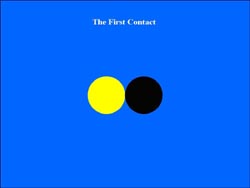
In a total solar eclipse there are four contacts between the Sun and the Moon as shown in Figure 4. Each of the four contacts marks an eclipse stage and the phenomena that occur through each stage.
Fig (4)
The four contacts of a total eclipse of the Sun
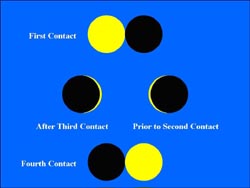
The Partial Eclipse Phase
Fig (5)
The partially eclipsed Sun
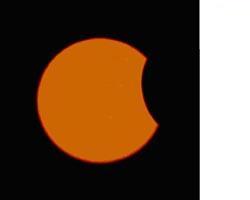
Photo by: Aymen Ibrahem
The photo was taken with a 3-inch refractor telescope with a solar filter.
A partial eclipse precedes the brief, splendid totality. This partial eclipse becomes observable in just under a minute after the first contact, when the Moon appears to cover up just a little portion of the Sun. The partial eclipse lasts about one hour and a half.
Through this partial eclipse, the Moon creeps across the Sun and it appears as if it were consuming the Sun slowly. No wonder the ancient Chinese imagined that a mighty dragon devours the Sun during solar eclipses. Even today, the Moon is popularly said to "take its first bite out of the Sun" during the first few minutes of a solar eclipse.
Fig (6)
The Moon takes the first bite out of the Sun
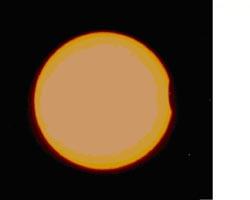
Photo by Aymen Ibrahem
One quarter of an hour before totality, the Sun becomes a blazing crescent! If you stand in the shadow of a leafy tree, you would see an amazing view of multiple images of this solar crescent, projected on to the ground. This happens as the little spaces among the leaves act like many natural pinhole cameras. We recommend taking photos of this view.
If there are no trees at the eclipse site, you can produce these images using a colander! Also, if you hold your hands with your fingers overlapping at right angles, you will see the same effect.
When 90%-95% of the Sun is eclipsed, the sky darkens noticeably, and shadows look very strange. If you hold your hand one way, the shadows of the fingers look very long and thin, as if the Sun were low in the sky. If the hand is swiveled around, they will look short and thick, as if the Sun were directly overhead.
The air temperature will drop considerably till the end of totality; if you observe the eclipse in a cold area, you must take coats with you.
As 99% of the solar disk becomes eclipsed, the most exciting phenomena of the eclipse follow rapidly.
Shadow Bands
A few minutes before totality, the Sun becomes a slender crescent and the sky darkens noticeably. If you look at the ground you will notice that there are narrow bands of light and shadow moving across the ground. These bands are termed shadow bands. They are caused by refraction of the light coming from the remaining solar crescent in the Earth's atmosphere.
The shadow bands are the atmospheric counterpart of the ripples of light seen at the bottom of a swimming pool on a sunny day. The shadow bands are usually of low contrast, and they are very difficult to photograph. However, a wide sheet of white paper may help to reveal them.
As the second contact is due, the sky darkens noticeably, and the lunar shadow is seen to rush across the ground. It is a time when little fear may be felt, but the ensuing eclipse spectacles soon catch the observers' eyes and hearts.
Baily's Beads
When it is about one minute before totality only a slit of the Sun remains visible! As the Moon's limb is not perfectly round (it is jagged as the lunar terrain is very rugged containing lofty mountains, deep valleys and craters), the last slit of the Sun shining through the lunar lowlands turns into shimmering pearls or beads on the lunar limb.
This phenomenon is named Baily's Beads after the British astronomer Francis Baily (1774-1844) who first noticed it in an annular solar eclipse on 15 May 1836.
Baily's Beads last only a few seconds.
Fig (7)
Bailey's Beads
http://www.cfa-www.harvard.edu/~peprbv/aruba98/beads.jpg The Diamond Ring
Immediately before the second contact, the last shard of the Sun gleams through the lunar lowlands and resembles a single glorious diamond on the lunar limb. The appearance of the eclipsed Sun at this moment resembles a diamond ring.
Fig (8)
The Diamond Ring
http://umbra.nascom.nasa.gov/eclipse/images/eclipse19951024_21.jpg
Chromosphere
After the diamond ring disappears, totality begins. The Moon has reached its second contact with the Sun's disk. You can remove your solar filter to view the totally eclipsed Sun.
A ring of pink light flashes for a few seconds around the Moon at the beginning of totality. This is the inner layer of the Sun's atmosphere, termed the solar chromosphere.
The word chromosphere derives from Greek, and means "the color sphere". The color of the chromosphere is due to a characteristic emission of hydrogen, the major constituent of the Sun. The chromosphere is about 2,000 km thick and has a temperature of over 50,000ºC.
Fig (9)
The chromosphere
http://www.vt-2004.org/mt-2003/mt-2003-sun-chromo-normal.jpg
Stars in the Daytime
As the Sun is completely hidden, the sky gets as dark as twilight, and if you look around, you will spot the brightest stars and planets. Usually, the planets Mercury and Venus are visible close to the Sun as they are the nearest planets to the Sun and they are bright enough. If any of the other five naked-eye planets exists above the horizon, it will be easily visible too.
Animal Behavior
Around and through totality animals get confused and behave as if night were coming. Birds fly to their nests and become silent, and bats fly. Animals become calm but nocturnal animals start to be active. Insects like bees stop flying, but be aware, mosquitoes emerge.
The Solar Corona
http://www.vt-2004.org/mt-2003/mt-2003-sun-corona-normal.jpg
The TOTALLY eclipsed Sun can be viewed safely without protection; you can enjoy the grandeur of the solar corona, the most admired of eclipse phenomena. When a total solar eclipse occurs, many amateur astronomers and eclipse enthusiasts travel thousands of kilometers to glimpse and photograph the corona!
The corona appears as a pearly white glow surrounding the Moon. It is bigger in size than the Sun itself. Actually it extends in space for several million kilometers, but it is also of a very low density. The corona is separated from the surface of the Sun by the chromosphere.
The corona is too faint to be seen in normal conditions (without eclipse) with the unaided eye as it is a million times fainter than the surface of the Sun and remains hidden in the glare of the solar disk. The brightness of the corona is similar to that of the Full Moon.
Solar astronomers, however, use sophisticated instruments and filters to observe the corona whenever needed. These instruments either block the Sun to make an artificial solar eclipse or pass only certain wavelengths of electromagnetic radiation (e.g., the ultraviolet or X-rays) that are characteristic of the coronal spectrum.
The amazing solar corona takes on various shapes. It may be circular or pentagonal in shape. It may have an irregular form or look like the wings of a bird. Its shape is related to the degree of the Sun's magnetic activity and varies from one eclipse to another.
The solar corona has a temperature of over 1 million degrees Celsius, i.e., it is in fact 200 times hotter than the surface of the Sun! Several theories have been put forward to explain the mystery of the enormous coronal heat, but the exact mechanism remains unknown.
Tongues of Flames
Also, through totality, another extraordinary solar phenomenon becomes visible. You can notice the presence of pink patches and loops hanging above the Moon. These are the solar prominences: huge, hot clouds of hydrogen that float in the solar atmosphere.
They take the forms of loops or jets and some resemble tongues of flame emanating from the Sun. Others look like fiery trees or fountains of fire. Some prominences may exceed 100,000 km in length.
The prominences may remain suspended in the solar atmosphere for several months, and when a solar flare (a type of solar eruptions) occurs, a nearby prominence may be hurled far into space with an incredible speed.
Fig (10)
The solar prominences
http://sohowww.nascom.nasa.gov/
Image credit: SOHO/NASA-ESA.
Third Contact
Immediately after the Moon makes the third contact totality ends. The eclipse stages are repeated in reverse order, beginning with the appearance of the chromosphere. You see first the chromosphere, then the diamond ring, Baily's Beads and the shadow bands, and then there is a partial eclipse again till the fourth contact.
Fourth Contact
When the very last portion of the Sun disk emerges from behind the Moon, the eclipse ends. The Moon is making the fourth contact. The New Moon has now disappeared in the daytime sky again. The eclipse is over and it is time to plan the next eclipse trip.
Ayman Mohamed Ibrahem PSC, senior astronomy specialist
|

